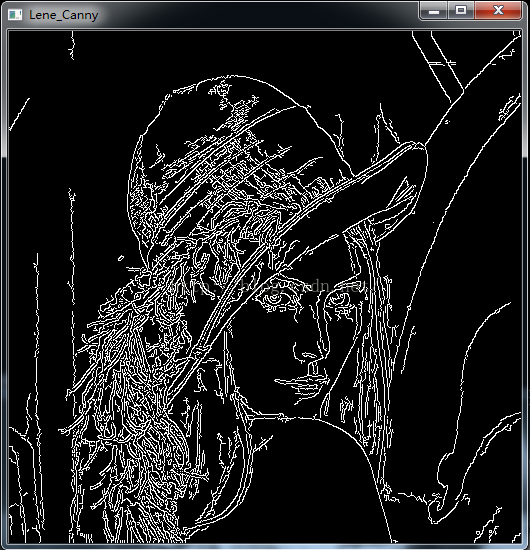OpenCV学习笔记一 (2016.12.3)
1、imread函数
函数定义:Mat imread(const string& filename, int flags=1 );
第一个参数为图像的路径,第二个参数flags为载入标识,指定一个加载图像的颜色类型,缺省为1,此时载入三通道的彩色图像。
flags取值:
CV_LOAD_IMAGE_ANYDEPTH- 如果取这个标识的话,若载入的图像的深度为16位或者32位,就返回对应深度的图像,否则,就转换为8位图像再返回。
CV_LOAD_IMAGE_COLOR- 如果取这个标识的话,总是转换图像到彩色一体。
CV_LOAD_IMAGE_GRAYSCALE- 如果取这个标识的话,始终将图像转换成灰度1。
如果想要载入最真实的图像,选择CV_LOAD_IMAGE_ANYDEPTH 或者 CV_LOAD_IMAGE_ANYCOLOR。
2、namedWindow函数
函数定义:void namedWindow(const string& winname,int flags=WINDOW_AUTOSIZE ); 用于创建一个窗口。
第一个参数,const string&型的name,即填被用作窗口的标识符的窗口名称。
第二个参数,int 类型的flags ,窗口的标识,可以填如下的值:
WINDOW_NORMAL设置了这个值,用户便可以改变窗口的大小(没有限制)
WINDOW_AUTOSIZE如果设置了这个值,窗口大小会自动调整以适应所显示的图像,并且不能手动改变窗口大小。
3.imshow函数
函数定义:void imshow(const string& winname, InputArray mat); 在指定的窗口(winname)中显示一幅图像。
第一个参数,const string&类型的winname,填需要显示的窗口标识名称。
第二个参数,InputArray 类型的mat,填需要显示的图像。4.waitKey函数
waitKey有两个作用:
1. It waits for x milliseconds for a key press.If a key was pressed during that time, it returns the key's ASCII code. Otherwise, it returns -1.(等待X毫秒的关键字输入,如果在此期间输入了关键词,那么返回关键词的ASCII码,否则结束返回-1)
2.It handles any windowing events, such as creating windows with cv::namedWindow(), or showing images with cv::imshow().(处理所有的窗口时间,例如使用namedWindow()函数创建一个窗口或者使用imshow()函数显示一副图像)
//版本一 VS2013 OpenCV2.4.13
//CMD命令调试:HelloOpenCV.exe lena.jpg
#include
#include
#include
using namespace cv;
using namespace std;
int main(int argc,char** argv){
//判断程序启动命令是否为二
if (argc!=2){
cout << "Usage:Read_ImageToLoadAndDisplay" << endl;
return -1;
}
//定义Mat类型的图像变量image
Mat image;
//读取图像
//函数定义:Mat imread(const string& filename, int flags=1 );
//flags为载入标识,指定一个加载图像的颜色类型,缺省为1。
image = imread(argv[1]);
//检查图像输入是否有效
if (!image.data){
cout << "could not open or find the image" << endl;
return -1;
}
//创建一个窗口用于显示图像
//函数定义void namedWindow(const string& winname,int flags=WINDOW_AUTOSIZE );
namedWindow("Display window",WINDOW_AUTOSIZE);
//图像显示
/*void imshow(const char *name, const CvArr *img)
{
cvNamedWindow(name, CV_WINDOW_AUTOSIZE);
cvShowImage(name, img);
cvWaitKey(0);
cvDestroyWindow(name);
}*/
imshow("Display window",image);
//waitKey有两个作用:
//1. It waits for x milliseconds for a key press.If a key was pressed during that time, it returns the key's ASCII code. Otherwise, it returns -1.
//2.It handles any windowing events, such as creating windows with cv::namedWindow(), or showing images with cv::imshow().
waitKey(0);
return 0;
} //版本二
//VS调试
#include
#include
#include
using namespace cv;
using namespace std;
int main(int argc, char** argv){
Mat image;
image = imread("F:/OpenCV_Stydy_WorkSpace/lena.jpg");
if (!image.data){
cout << "could not open or find the image" << endl;
return -1;
}
namedWindow("Display window", WINDOW_AUTOSIZE);
imshow("Display window", image);
waitKey(0);
return 0;
} 本人初学OpenCV,C++编程亦很不熟练,代码尚有不完善的地方,敬请指教!
5、输出图像到文件imwrite函数
函数定义:bool imwrite(const string& filename,InputArray img, const vector第一个参数,const string&类型的filename,填写将图像写入文件的路径及图像的名称和后缀。
第二个参数,InputArray类型的img,一般填一个Mat类型的图像数据就行,即将要输出到文件中的图像数据。
第三个参数,const vector
#include"opencv2/opencv.hpp"
#include
using namespace cv;
using namespace std;
int main(int argc, char** argv){
Mat image;
image = imread("F:/OpenCV_Stydy_WorkSpace/lena.jpg");
if (!image.data){
cout << "could not open or find the image" << endl;
return -1;
}
//Canny提取边缘,并将结果存储与result
Mat result;
Canny(image,result,50,150);
imshow("Lene_Canny",result);
imwrite("lena_Canny.png",result);
waitKey(0);
return 0;
} 
